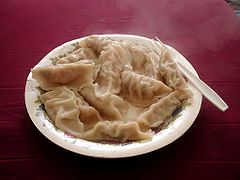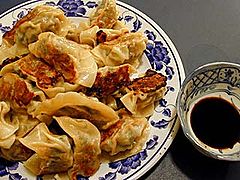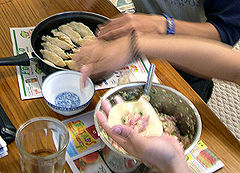- Jiaozi
-
For other uses, see Jiaozi (disambiguation).
Jiaozi Chinese name Traditional Chinese 餃子 Simplified Chinese 饺子 Hanyu Pinyin jiǎozi Transcriptions Mandarin - Hanyu Pinyin jiǎozi Min - Hokkien POJ kiáu Cantonese (Yue) - Jyutping gaau2 zi2 Alternative Chinese name Traditional Chinese 鍋貼 Simplified Chinese 锅贴 Literal meaning pot sticker Transcriptions Mandarin - Hanyu Pinyin guōtiē Min - Hokkien POJ ue-tah or e-tah or 煎餃 (chian-kiáu) Cantonese (Yue) - Jyutping wo1 tip3 Second alternative Chinese name Traditional Chinese 扁食 Literal meaning flat food Transcriptions Mandarin - Hanyu Pinyin biǎn shí Japanese name Kanji 餃子 Transcriptions - Revised Hepburn gyōza Korean name Hangul 교자 Transcriptions - Revised
Romanizationgyoja - McCune-
Reischauerkyoja Nepali name Nepali म:म: or ममचा Jiǎozi 餃子 or 饺子 (Chinese transliteration), gyōza (Japanese transliteration), Mo:Mo: or Momocha म:म: or ममचा (Nepali transliteration), or pot sticker is a Chinese dumpling widely spread to Japan, Eastern and Western Asia.
Jiaozi typically consist of a ground meat and/or vegetable filling wrapped into a thinly rolled piece of dough, which is then sealed by pressing the edges together or by crimping. Jiaozi should not be confused with wonton: jiaozi have a thicker, chewier skin and a flatter, more oblate, double-saucer like shape (similar in shape to ravioli), and are usually eaten with a soy-vinegar dipping sauce (and/or hot chili sauce); while wontons have thinner skin, are sphere-shaped, and are usually served in broth. The dough for the jiaozi and wonton wrapper also consist of different ingredients.
Contents
Chinese version
Types
Chinese dumplings (jiaozi) may be divided into various types depending on how they are cooked:
- Boiled dumplings; (shuijiao) literally "water dumplings" (水餃; pinyin: shuǐjiǎo).
- Steamed dumplings; (zhengjiao) literally "steam-dumpling" (蒸餃; pinyin: zhēngjiǎo).
- Shallow fried dumplings (guotie) lit. "pan stick", known as "potstickers" in N. America, (鍋貼; pinyin: guōtiē), also referred to as "dry-fried dumplings" (煎餃; pinyin: jiānjiǎo).
Dumplings that use egg rather than dough to wrap the filling are called "egg dumplings" or (蛋餃; pinyin: dànjiǎo). Cantonese style Chinese dumplings (gaau) are standard fare in dim sum. Gaau is simply the Cantonese pronunciation for 餃 (pinyin: jiǎo). The immediate noted difference to jiǎozi is that they are smaller and wrapped in a thinner translucent skin, and usually steamed. In other words, these are steamed dumplings. The smaller size and the thinner pastry make the dumplings easier to cook through with steaming. Fillings include shrimp, scallop, chicken, tofu, mixed vegetables, and others. The most common type are shrimp dumplings (har gow). In contrast to jiǎozi, gaau are rarely home-made. Similar to jiaozi, many types of fillings exist, and dim sum restaurants often feature their own house specials or innovations. Dim sum chefs and artists often use ingredients in new or creative ways, or draw inspiration from other Chinese culinary traditions, such as Chiuchow, Hakka, or Shanghai. More daring chefs may even incorporate a fusion from other cultures, such as Japanese (teriyaki) or Southeast Asian (satay, curry), while upscale restaurants may use expensive or exotic ingredients such as lobster, shark fin and bird's nest. Another Cantonese dumpling is the jau gok.
Fillings in Dumplings
Common dumpling meat fillings include pork, mutton, beef, chicken, fish, and shrimp which are usually mixed with chopped vegetables. Popular vegetable fillings include cabbage, scallion (spring onions), leek, and garlic chives. Dumplings are eaten with a soy sauce-based dipping sauce that may include vinegar, garlic, ginger, rice wine, hot sauce, and sesame oil.
Jiaozi's origin and development
Jiaozi are one of the major foods eaten during the Chinese New Year and year round in the northern provinces. They look like the golden ingots yuan bao used during the Ming Dynasty for money and the name sounds like the word for the earliest paper money, so serving them is believed to bring prosperity. Many families eat these at midnight on Chinese New Year's Eve. Some cooks will even hide a clean coin for the lucky to find.
Jiaozi were so named because they were horn shaped. The Chinese for "horn" is jiǎo (角), and jiaozi was originally written with the Chinese character for "horn", but later it was replaced by a specific character 餃, which has the food radical on the left and the phonetic component jiāo (交) on the right.[1]
According to folk tales, jiaozi were invented by Zhang Zhongjing, one of the greatest practitioners of traditional Chinese medicine in history. They were originally called "tender ears" (娇耳; pinyin: jiao'er) because they were used to treat frostbitten ears.
Jiaozi are eaten all year round and can be eaten at any time of the day – breakfast, lunch or dinner. They can constitute one course, starter or side dish, or the main meal. Every family has its own preferred method of making them, with favourite fillings, and of course, jiaozi types and preparation vary widely according to region.Japanese version
 Hamamatsu Gyōza
Hamamatsu Gyōza
The Japanese word Gyōza (ギョーザ, ギョウザ) was derived from the reading of 餃子 in the Shandong Chinese dialect (giaozi) and is written using the same Chinese characters.
The most prominent differences of Japanese-style gyōza from Chinese style jiaozi are the rich garlic flavor, which is less noticeable in the Chinese version, and the fact that Japanese gyōza are very lightly flavored with salt, soy, and that the gyōza wrappers are much thinner. They are usually served with soy-based tare sauce seasoned with rice vinegar and/or Rāyu (known as chili oil in English, làyóu (辣油) in China). The most common recipe found is a mixture of minced pork, cabbage, and Nira (Chinese chives), and sesame oil, and/or garlic, and/or ginger, which is then wrapped into thinly-rolled dough skins. In essence, gyōza are similar in shape to pierogi.
Gyōza can be found in supermarkets and restaurants throughout Japan. Pan-fried Gyōza are sold as a side dish in almost all ramen and Chinese restaurants.
The most popular preparation method is the pan-fried style called Yaki-gyōza (焼き餃子), in which the dumpling is first fried on one flat side, creating a crispy skin. Then, water is added and the pan sealed with a lid, until the upper part of the gyōza is steamed. Other popular methods include boiled Sui-gyōza (水餃子) and deep fried Age-gyōza (揚げ餃子).
Store bought frozen dumplings are often prepared at home by first placing them in a pot of water which is brought to a boil, and then transferring them to a pan with oil to fry the skin.
Nepali version of Momo
The Nepali version is known as Momo (म:म). The word "Momo" comes from a Chinese loanword "Momo" (馍馍).[2] which translates to "Steamed Bread". When preparing Momo, flour is filled, most commonly with ground Water Buffalo meat. Often, ground lamb or chicken meats are used as alternate to water buffalo meat. Finely chopped onion, minced garlic, fresh minced ginger, turmeric, cumin powder, coriander/cilantro, etc are added to meat for flavoring. Sauce made from cooked tomatoes flavored with timur (Szechwan pepper), minced red chilies is often served along with momo.
Guotie
Guotie (simplified Chinese: 锅贴; traditional Chinese: 鍋貼; pinyin: guōtiē; literally "pot stick") is pan-fried jiaozi, also known as potstickers in North America, or yaki-gyoza in Japan. They are a Northern Chinese style dumpling popular as a street food, appetizer, or side order in Chinese. This dish is sometimes served on a dim sum menu, but may be offered independently. The filling for this dish usually contains pork (sometimes chicken, or beef in Muslim areas), cabbage (or Chinese cabbage and sometimes spinach), scallions (spring or green onions), ginger, Chinese rice wine or cooking wine, and sesame seed oil.
Guotie are shallow-fried in a wok (Mandarin 'guo'). A small quantity of water is added and the wok is covered. While the base of the dumplings is fried, the upper part is steamed and this gives a texture contrast typical of Chinese cuisine.
An alternative method is to steam in a wok and then fry to crispness on one side in a shallow frying pan.
Exactly the same dumpling is boiled in plenty of water to make jiaozi and both are eaten with a dipping sauce.
Three or five folds are made on one side of the round wrapper that is rolled so that the edges are thinner than the middle. This gives the base a large surface area that helps to give the dumpling stability to stand up in the pan.
The Chinese method of preparing the dough is to pour boiling water onto the flour and letting stand for five minutes and then adding a small quantity of cold water. This helps to activate the gluten in the dough.
Other names for guotie:
- Peking Ravioli — In Boston, guotie are known as "Peking ravioli", a name first coined at the Joyce Chen Restaurant in Cambridge, MA, in 1958.[3]
- Wor tip (Cantonese Jyutping: wo1 tip3) is the Cantonese name for guotie'
History
The guotie is said to date back over four millennia. However, the first mention in literature dates back to the Song Dynasty (960-1280 AD) in ancient China reporting the guotie as being exceptionally good for the human soul.
See also
- Dumpling
- Har gow -- Chinese shrimp dumpling
- Jau gok
- Fish ball
- Beef ball
- Wonton
- Pierogi
- Pelmeni
- Ravioli
- Varenyky
- Mantı
- Mandu (dumpling) and Mandugwa
- Kreplach
- Baozi (steamed)
- Khinkali
- Momo (food)
- Buuz, Khuushuur, Bansh, the Mongolian variants (steamed, fried, boiled, respectively)
References
- ^ Norman, Jerry (1988) Chinese, Cambridge University Press, p76-77.
- ^ Jīn Péng 金鹏 (ed.): Zàngyǔ jiǎnzhì 藏语简志. Mínzú chūbǎnshè 民族出版社, Beijing 1983, p. 31.
- ^ chinesefood.about.com
External links
Hakka cuisine Shanghai cuisine Shanghai cuisine · Chinese mitten crab · Ci fan tuan · Cu mian · Jiaozi · Lion's head · Nanxiang Steamed Bun Restaurant · Nian gao · Shanghai fried noodles · Shengjian mantou · Song gao · Sou (pastry) · Tang bao · Tea egg · Wonton · XiaolongbaoChinese New Year Topics Chinese dragon · Chinese New Year · CCSTV New Year's Gala · CCTV New Year's Gala · Chinese New Year in Singapore · Chunyun · Lion dance · New Year picture · Red envelope · Reunion dinner · San Francisco Chinese New Year Festival and Parade · Color in Chinese culture · Fireworks · Firecracker · Dragon dance · NianFood Bakkwa · Buddha's delight · Fa gao · Fat choy · Jau gok · Jiaozi · Kralan · Kuih · Lotus seed · Nian gao · Reunion dinner · Spring pancake · Squab (food) · Taro cake · Turnip cake · Yusheng · Melon seed · Mandarin orange · Fish · PineappleAmerican cuisine Latin AmericaAsian cuisine East AsiaChinese: Baozi · Ci fan tuan · Dim sum · Fun guo · Har gow · Hujiao bing · Jau gok · Jiaozi · Lo mai gai · Shengjian mantou · Shumai · Siopao · Suanla chaoshou · Tang bao · Tangyan · Taro dumpling · Wonton · Xiaolongbao · Zhaliang · Zongzi · Other: Akashiyaki · Buuz · Dango · Khuushuur · Mandu · Mandugwa · Manduguk · Mitarashi dango · MomoSouth East AsiaVietnamese: Ba-wan · Bánh bao · Bánh chưng · Bánh lá · Bánh tẻ · Bánh tét · Other: Caozai Guo · Kueh tutu · Kuih kochi · NagasariWest AsiaNorth AsiaEuropean cuisine Bryndzové halušky · Halušky · Kalduny (Kundumy) · Kopytka · Pierogi · Scovardă · Shlishkes · Strapačky · Uszka · VarenykySouthern EuropeCentral EuropeCapuns · Kluski · Knedle · Knödel · Maultasche · Mohnnudel · Pickert · Schupfnudel · Silesian dumplingsWestern EuropeNorthern EuropeOther AustraliaCategories:- Dumplings
- Dim sum
- Chiuchow cuisine
- Hakka cuisine
- Shanghai cuisine
- Cantonese cuisine
- Appetizers
- Japanese cuisine
- Korean cuisine
- Chinese New Year foods
- American Chinese cuisine
- Canadian Chinese cuisine
- Street food
Wikimedia Foundation. 2010.





